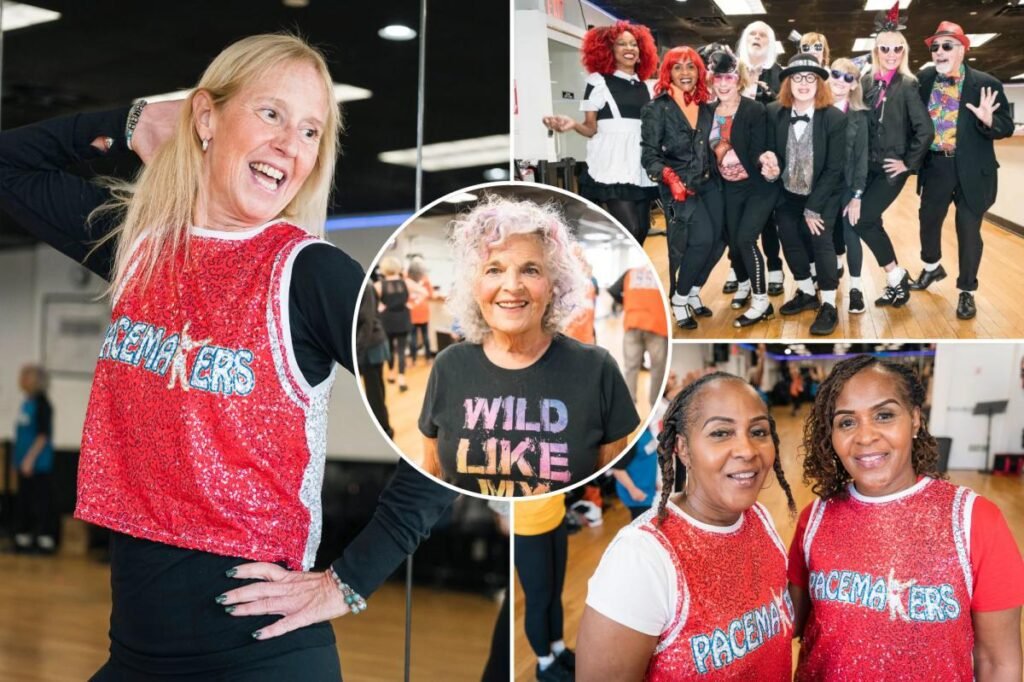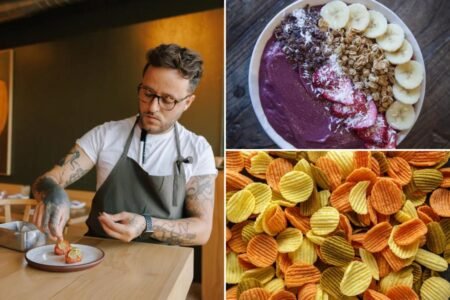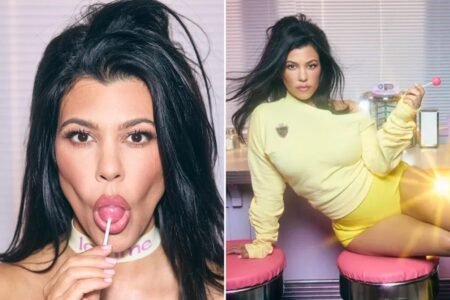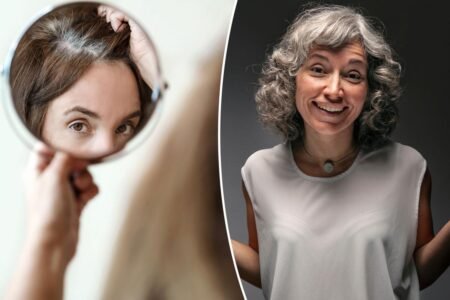On the dance floor, Phyllis Bogart moves like she’s made of electricity, not metal.
At 78, her pink-and-purple-streaked curls bounce as she shimmies and shakes with the energy of someone half her age, each twirl punctuated by a wide, wild grin.
It’s clear that four hip replacements, a mechanical knee and a string of other surgeries haven’t slowed her down — though they did earn her a nickname.
“With all the titanium in my body, I’ve become known as the bionic babe,” Bogart told The Post.
The retired nurse and pharmaceutical rep is a member of the Pacemakers — a precision dance troupe that’s redefining what it means to be a senior, helping people in their 60s, 70s and even 80s stay active both mentally and physically.
“I’m older,” Bogart said. “But I’m also vital. I’m exciting. I’m active. I’m alive — and I’m not invisible.”
From cyberbullying to center stage
Founded in 2019, the NYC-based Pacemakers sprang to life after founder Susan Avery faced ageist backlash as the oldest dancer for the Brooklyn Cyclones.
“Look at this old bag dancing, who does she think she is?” one person commented on a video of her performance. “Go home,” and “stay in the kitchen where you belong,” others added.
“That is how I learned what it was like to be cyberbullied,” said Avery, 65, recalling the 2017 incident. “I was devastated.”
But instead of letting it defeat her, Avery says her daughter urged her to channel the hurt into action.
So Avery placed an ad in Playbill inviting seniors to audition for a new senior dance team. Sixteen performers answered the call.
“Our first performance was July 6, 2019,” she said. “I was so nervous, but we ended up getting a standing ovation — and our dance card has been full ever since.”
Senior moves, global grooves
Now seven seasons in, the Pacemakers boast 47 members and have won fans around the globe with viral performances that have racked up millions of views online.
The team performs for hundreds of thousands of fans each year, appearing frequently at sporting events, community centers, festivals and conferences across the Northeast. They’ve even been on The Drew Barrymore Show and traveled to Austria twice to teach their European admirers.
“We are old, but that doesn’t take away from the fact that we’re fun, we’re powerful, we’re sexy. We’re all these other things too.”
Susan Avery, 65
While you have to be 60 to join, the group hosts workshops and “day discos” open to all ages.
Notably, only two members have professional dance training; the rest come from healthcare, education, law enforcement, journalism and a variety of other fields — including a lawyer-turned-library worker who writes erotica in his spare time.
But there’s one thing they all share: a fearless approach to aging.
“Growing up, people would say, ‘Oh, when you hit 40, it’s over,’” Pacemaker Sparkle Lee, 65, said. “Now when you look at us, you realize it’s not.”
During performances, each member wears their birth year on the back of their jersey, loud and proud.
“There’s none of this ‘young at heart’ stuff,” Avery said. “We are old, but that doesn’t take away from the fact that we’re fun, we’re powerful, we’re sexy. We’re all these other things too.”
Stronger, sharper and still dancing
As the Pacemakers embrace their senior status, members say the group helps them stay well as they get older.
“I never thought at this age that I would be involved in something so exciting, so energizing, so fun and so challenging to my body and my brain,” Bogart said. “It’s been the best part of my senior years.”
Studies show that learning choreography is excellent for the brain, engaging memory, focus, coordination, timing, rhythm and movement simultaneously. Research suggests it helps slow cognitive decline and may even reduce the risk of developing dementia.
“What’s better than standing in front of an audience and just dancing and shaking your tush?”
Serena Kindler, 59
The Pacemakers are also getting a full-body workout. Their complex routines require strength, flexibility and balance, helping members stay physically fit — a crucial factor for seniors who want to stay healthy, active and independent.
“This isn’t a gym, it’s the next level,” Star Lee, Sparkle’s twin sister, said. “You just have to keep it moving.”
The group also creates a community, preventing social isolation and loneliness common among older Americans.
“Being a senior, socialization is vital for our health,” Bogart said. “I know that because I see people that just sit in their house and wither away.”
Pacemaker Nicole Ash, 61, said she gets more hugs at Saturday rehearsals than she does all week.
“When you’re in your 60s, 70s, 80s and you’re growing in mind, body and spirit, it can’t help but transform you,” she said.
Twirling through trials and treatments
Even with all the benefits of being a Pacemaker, aging brings hurdles.
“There’s not a week that goes by that somebody doesn’t have an ache or a pain,” Avery said.
Dance captain Joanne Wolfring knows this firsthand. In 2023, doctors removed a nodule from her lung, temporarily sidelining her from practice.
Slowly, she returned to the dance floor. Then, one evening while tapdancing at a Brooklyn Cyclones game, she felt fluid in her chest and shortness of breath. Still, the show went on.
“Later, I went to the doctor and sure enough, I had what they call an abnormal thorax, which was a collapsed lung, and I needed another surgery,” Wolfring, 63, said. “Meanwhile, here I was dancing away.”
Still, she attended rehearsals to learn choreography during recovery.
“I would look forward to going on Saturday just to sit there, to see everybody,” Wolfring said. “When you come in that door, you leave everything that’s going on behind you. It’s like another world.”
To support members facing health battles and other hardships, Wolfring helped start the Sunshine Club, which sends flowers, cards, meals and even makes home visits to Pacemakers in need.
Last year, when Serena Kindler experienced a relapse of ovarian cancer, her teammates sat with her during chemotherapy, reminding her of one small reason to keep fighting: to perform again.
“It’s a huge part of my life, and to be able to come back and celebrate life through dance and through joy and through friendships, it’s given me strength,” the 59-year-old said. (She was grandfathered in before the Pacemakers raised their starting age to 60.)
Back in the mix, Kindler said moving her body is its own kind of medicine.
“What’s better than standing in front of an audience and just dancing and shaking your tush?” she said. “It takes the anxieties and stresses of life and what I’m going through out the door so I can just focus on me.”
Henrietta Benton, 68, agrees.
“The dancing we do is therapeutic,” she said. “I have some ailments — we all do — but when you dance, it’s like an anesthetic. The pain just goes away.”
Proof that age is just a number
Earlier this month, more than 100 seniors registered for Pacemakers tryouts, vying for just 12 open spots. Attendees learned choreography on the spot and showed off their freestyle moves.
Gerald Timberlake, 70, approached the audition with a mix of nerves and excitement.
“I’ve been dancing since I could walk, but I’ve never had formal training,” said the Harlem-based artist.
When asked why he wanted to join, Timberlake explained, “I embrace every morning I wake up. I just wanted to do something different with my life.”
It turns out, he got his wish. Timberlake was unanimously selected by a panel of judges to join the Pacemakers, along with 11 other new recruits.
Even for those who don’t make the team, Bogart said the goal is to inspire seniors to dream big.
“People say, ‘Oh, you’re older, can you do all that?’ Well yes, you can, because I have,” she said. “You have to find your niche, your outlet. You can do whatever you want to do.”
Read the full article here












